The first frosts of winter have encouraged trees to shed their last leaves, and deciduous species are now bare. Clumps of mistletoe are clearly visible, often high in the branches of willow or poplar, the beaks and feet of birds spreading the sticky seeds of this parasitic plant.
Wildlife to see in December 2019
View south over the Somerset Levels from Walton Hill on a misty winter evening with snow on the ground. View includes Butleigh Moor, Somerton Moor, Street Moor, Low Ham Moor, Walton Moor, Pitney Moor, Huish Moor - Guy Edwardes
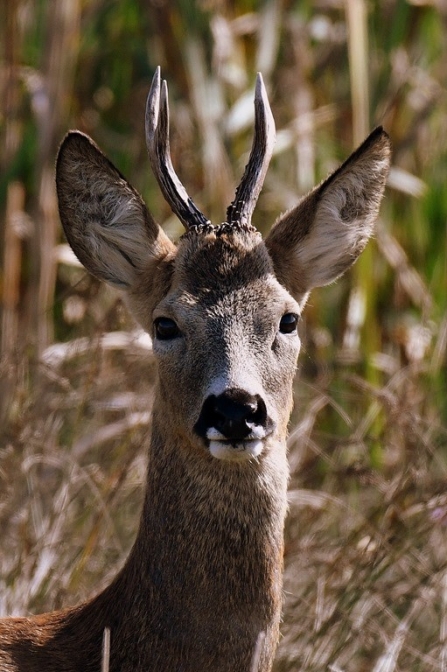
Roe buck at Steart - Chris Chappell
Dormice, hedgehogs and reptiles are settling into hibernation. Garden birds will readily come to feeders, as the natural sources of food diminish. A great variety of species will use feeders, from warblers to woodpeckers. Feeding the birds is particularly beneficial during periods of frost and snow.
Migrant ducks have now settled in on the levels, noisy flocks of wigeon and teal are dominant, plus shoveler and pintail. Snipe, lapwing and golden plover will also spend the winter on the flooded levels, all spectacular birds when seen in close-up.
All birds spend a great deal of their lives preening, as they will not survive if their plumage is not in good condition - this is all the more important for water birds.
Redwing and fieldfare, along with migrant and resident blackbirds are feeding on the heavy berry crop, quickly stripping the branches of fruits. Both are striking birds, the fieldfare a large thrush with a noisy chattering cackle, the redwing the smallest thrush, and mostly silent, but has a high chip-chip call when disturbed.
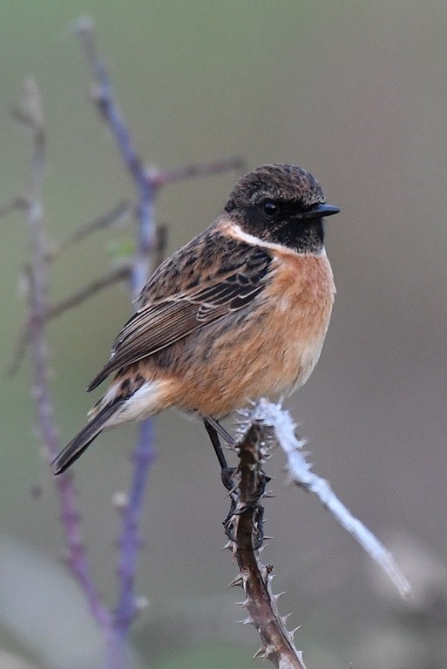
Male stonechat - Chris Chappell
The stonechat will strike a pose on a reed head, making short forays to catch insects, their preferred food. They are attractive birds, the male with white ring around the neck, dark eyes, and soft pinky-brown chest. Their colouring very much toned down from the spring and summer plumage, and their eponymous call made less often. The female is a pretty bird but without the white neck ring and black head.
Many birds exhibit flocking behaviour at this time of year. Starlings are well known on the Avalon marshes, providing a twice daily display as the arrive at, and leave their roost. But many other birds also gather in large numbers; small birds such as linnets and goldfinches form flocks of some hundreds.
Dunlin and knot will also provide spectacular shows as they turn in the light over Bridgwater Bay. This is thought to be primarily a tactic to avoid predation, as raptors are thought to find it hard to distinguish individual birds within a swirling mass.

Starlings on a wire - Chris Chappell
The shoveler duck cuts a rather comic figure with oversize bill and bright eyes, plus orange feet. They often feed by swimming in a small circle to stir up the sediments they feed from. Groups of shoveler keep up a grunting contact call, and as a heavy bird, their wings make a very distinctive rattle when they take off.
While just a handful of shoveler stay here to breed, they are fairly common in winter, birds that have arrived from the north, while our breeding birds will head south.
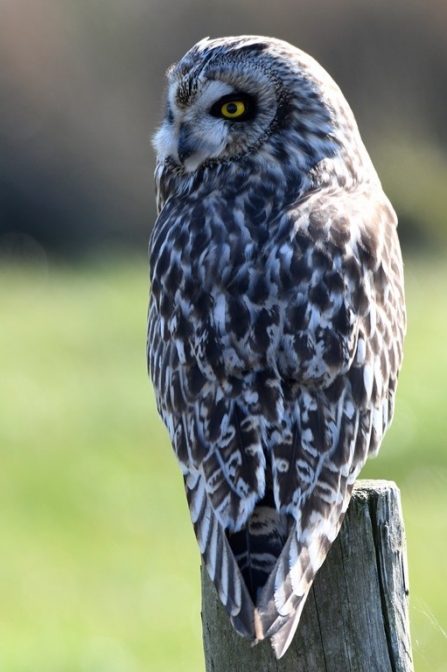
Short-eared owl - Chris Chappell
Short eared Owls
Many of these beautiful birds arrive from Scandinavia, Iceland and Russia to join a small native population, and will spend the winter in the UK. Here in Somerset they may be seen on the levels, and along the coast, on any open grassland where they can find their primary prey source, the field vole.
With broad wings, they are silent in flight, swooping and diving as they seek a meal. They prefer to hunt during the day, unlike most owls, which are primarily nocturnal hunters. The short eared owl have the appearance of a huge moth, with a wingspan of up to 1 metre, but weighing in at just 330 grams.
It is always a treat to spot such a bird making its way along hedge or bank, gliding with head down, before pouncing on its prey. Equally, they spend a lot of time perched on a post, sometimes on a fence by a roadway, and are reluctant to move, even when a car passes just feet away.
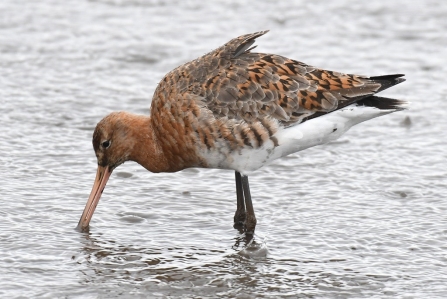
Black-tailed Godwit feeding - Chris Chappell
Black Tailed Godwit
This impressive large wader over-winters in Somerset, on the coast, and increasingly on the Levels. Arriving from Iceland, the UK hosts some 45,000 birds, scattered along the coast, and small flocks will be seen inland wetland areas, including the Levels.
They are impressive in flight, having black and white chevrons on the wings, and fly in tight formation, twisting and turning in the air. At this time of year the black tailed godwit has a grey body, which turns russet as the breeding season approaches. Probing the mud for invertebrates, the larger female has a longer bill, allowing the sexes to feed on a different strata of prey species.
A group will keep in touch with a guttural 'zuk' call, but they will become noisy if threatened. Of conservation red status, meaning threatened, Somerset provides a major refuge for these unique birds. They are regular visitors to SWT Catcott.
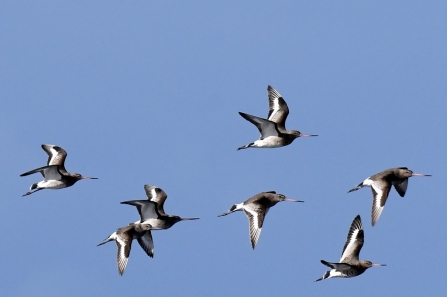
Godwits in flight - Chris Chappell
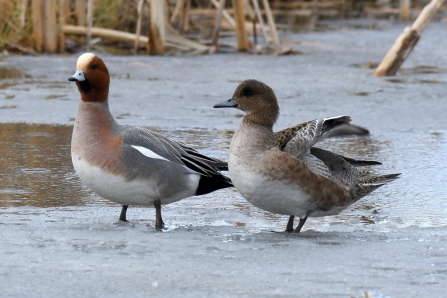
Wigeon on ice - Chris Chappell
Wigeon
The wigeon (anas penelope) is arguably the most striking of our common winter ducks, the drake beautifully coloured in shades of grey and pink, russet neck and head, black and white rump, cream crown to the head, and black and white rear end. The beak is pale blue, with a black tip. The female wigeon a subtle mixture of dappled scalloped brown. They are a medium sized duck, smaller than a mallard. Both sexes are pale underneath and have dark eyes.
Wigeon survive on vegetable matter, often seen grazing on lush grass. The males have a loud whistle, which is distinctive, and they will call noisily when excited. It is estimated some 450,000 wigeon arrive in the UK from Scandinavia, Iceland and Russia each autumn, and leave in early spring to return to their breeding grounds. SWT Catcott is a good spot to see them.
Wildlife in the garden
As the weather turns colder, birds will increasingly be drawn to feeders in the garden, and this provides a chance for you to watch them close up. A large range of species will come to most gardens, depending on the local environment.
The very pretty bullfinch will happily eat seeds from a feeder, a bird that has traditionally been persecuted because of its fondness for fruit blossom buds, but is now making a comeback. Another bird that has joined our winter population is the blackcap, many of which have altered their behaviour such that our summer birds are replaced by birds from eastern Europe. The reed bunting is now common at feeders in gardens adjacent to any marshy lowland areas.
Nearby wooded areas the great spotted woodpecker and nuthatch will also be seen. The fieldfares and redwings are attracted to berries on shrubs, and when those run out, are very fond of soft apples left on the ground, so do leave some behind if you have an apple tree or orchard.
Another visitor you may see is the brambling, often travelling with other finches, the male is a striking bird with buff chest, grey speckled head, but most distinctively, a black Zorro like mask around the eyes.
It is worth providing different types of seed feeders, as goldfinches prefer small seeds like niger, the tits will feed from an upturned coconut half on a string, full of fat. Other species will struggle to get to this, and so cannot compete. And do allow for ground feeders such as robin and dunnock, plus of course the blackbirds, making sure the feed is not too near any cover that cats may spring from.
For those with a garden, it is a good time to think about what you might plant before spring. Choosing shrubs that bear berries, such as pyracantha, will attract birds. Buddleia is well known for attracting butterflies.
If you have space for a climber, clematis cirrhosa is an evergreen, winter flowering plant, which will feed bees even in winter, and provides year round greenery and dense growth for robins or blackbirds to use as nesting sites. And if you have room for some tree saplings, all the better. Just one tree will support hundreds of species, from lichens to beetles. Talk to you garden centre for advice.

Levels sunset - Chris Chappell

